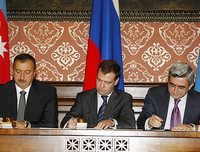Last weekend, graduate students at the University of Kentucky failed to resolve the Nagorno-Karabakh dispute. In and of itself this was not surprising, and did not distinguish last Friday and Saturday from a typical weekend in Lexington, Kentucky. What made the weekend special was that students at the Patterson School of Diplomacy and International Commerce, the terminal Masters program in foreign affairs where I teach, in conjunction with the Army War College, ran through the International Strategic Crisis Negotiation Exercise, a simulation of the Nagorno-Karabakh stand-off designed to expose students to the problems of international negotiations.
The exercise involved dividing 75 Patterson School students into seven teams, representing Armenia, Azerbaijan, Nagorno-Karabakh, Russia, Turkey, Iran, and the United States. Mentors for the teams included three retired ambassadors, a U.S. Army colonel, and several faculty members with expertise on the Caucasus. The simulation was conducted over two days, with teams holding bilateral and multilateral meetings interspersed by delegation conferences. Any significant departure from instructions required the approval of the home government, played by a team of managers from the Army War College. Communication between teams was restricted to official channels, although the students reportedly strained the boundaries of this system through informal attempts at espionage and misdirection. A public meeting with a U.N. special representative, played by Professor Laura Neack of Miami University, capped the simulation, and gave each team the opportunity to publicly state its final positions on Nagorno-Karabakh.
The Army War College's Center for Strategic Leadership (CSL) has conducted at least 22 iterations of this simulation. Eleven of these have been held at the Army War College, and have involved members of the International Fellows Program, made up of senior foreign military officers. The other simulations have taken place at foreign policy programs at schools such as the Woodrow Wilson School of International Affairs at Princeton, the George H. W. Bush School of Government and Public Service at Texas A&M, and the Institute for the Study of Diplomacy at Georgetown. The 2010 Patterson exercise represented the largest simulation thus far.

